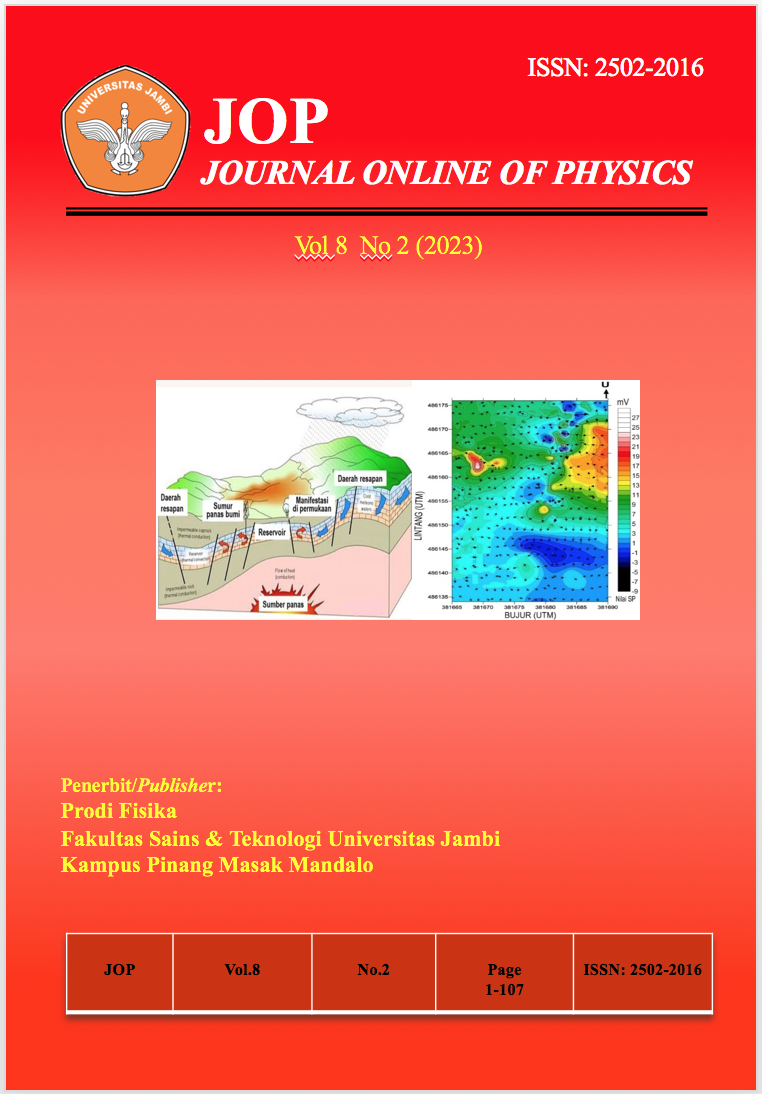MANIFESTASI PANAS BUMI SERTA REKOMENDASI PEMANFAATANNYA DI DESA KOTO SANI DAN SEKITARNYA, KECAMATAN X KOTO SINGKARAK, KABUPATEN SOLOK, PROVINSI SUMATRA BARAT
DOI:
https://doi.org/10.22437/jop.v8i2.22184Keywords:
Geothermal Manifestations, Fluid Geochemistry, Direct Use and Indirect UseAbstract
The volcanic arc or volcanic arc that extends along the western side of Sumatra Island. Koto Sani Village, Kec. X Koto Singkarak, Solok Regency, West Sumatra Province is one of the areas on Sumatra Island that has geothermal potential. In terms of the developing tectonic order, namely in the form of a geological structure in the form of the Sumani segment of the Sumatra Fault which moves in a strike slip to the right or dextral. This geological structure is one of the main components forming the geothermal system apart from the heat source, reservoir rock, stratigraphic characteristics and the cap layer. This study aims to determine the geological setting, any geothermal manifestations found in the study area and estimate the temperature below the surface for recommendations for its use. The research method used was the interpretation of satellite imagery on the 1:25,000 scale of the Indonesian Rupa Bumi map (RBI), surface geological mapping, measurement of the physical characteristics of geothermal fluids, geochemical analysis of geothermal fluids (anion-cation) and then plotting Giggenbach's triangle diagram (1991). and geothermal geothermal calculations, as well as analysis of 18O and 2H isotopes. The research area generally forms a landscape of elongated hills with quite steep valleys as a result of tectonic activity in the form of geological structures as migration routes of hot fluids from the reservoir to the surface. This is reinforced by the results of the interpretation of river flow patterns, namely meandering or sub-dendritic and elongated or called parallel as an indication of disturbance from faults or faults. Geothermal manifestations found are hot springs, sintered silica and hydrothermal alteration rocks. The estimated temperature below the surface is 407.64°C with a high temperature category and is recommended for direct use, such as the tourism and fisheries sector, as well as indirect use, such as geothermal energy power plants.
Downloads
References
Ditjen EBTKE dan Badan Geologi Kementrian ESDM. 2017. Buku Potensi Panas Bumi Jilid 1. Jl. Pegangsaan Timur No.1 Menteng, Jakarta, 10320: Direktorat Jenderal Panas Bumi Energi Baru Terbarukan dan Konservasi, Kementrian Energi Sumber Daya Mineral.
Giggenbach, W. F. 1991. Chemical Techniques in Geothermal Exploration. Application of Geochemistry in Geothermal Reservoir Development, F. D’Amore (Ed.),UNITAR-UNDP, Rome, 252-270.
Hamilton, W. 1979. Tectonic of Indonesian Region. US Geological Survey Professional Paper, 345-459.
Kasbani. (2009). Tipe Sistem Panas Bumi di Indonesia dan Estimasi Potensi Energinya. Buletin Sumber Daya Geologi, 4 (3), 19-26.
Metcalfe, I. 2017. Tectonic Evolutions of Sundaland. Bulletin of The Geological Society of Malaysia, 63, 27-60.
Natawidjaja, D. H. 2018. Updating active fault maps and sliprates along the Sumatran fault zone Indonesia. IOP Conf. Series: Earth and Environmental Science,,188, 1-10. doi :10.1088/1755-1315/118/1/012001.
Oktariadi, O. 2017. Warisan Geologi Ranah Minang, Panduan Menuju Geopark Global. Bandung: Pusat Air Tanah dan Geologi Tata Lingkungan Badan Geologi KESDM.
Silitonga, P. H., dan Kastowo. 1995. Peta Geologi Regional Lembar Solok Skala 1:250.000 Edisi 2. Bandung, Indonesia: Pusat Penelitian dan Pengembangan Geologi.
Van Bemmelen, R. W. 1949. The Geology of Indonesia. Government Printing Office.











